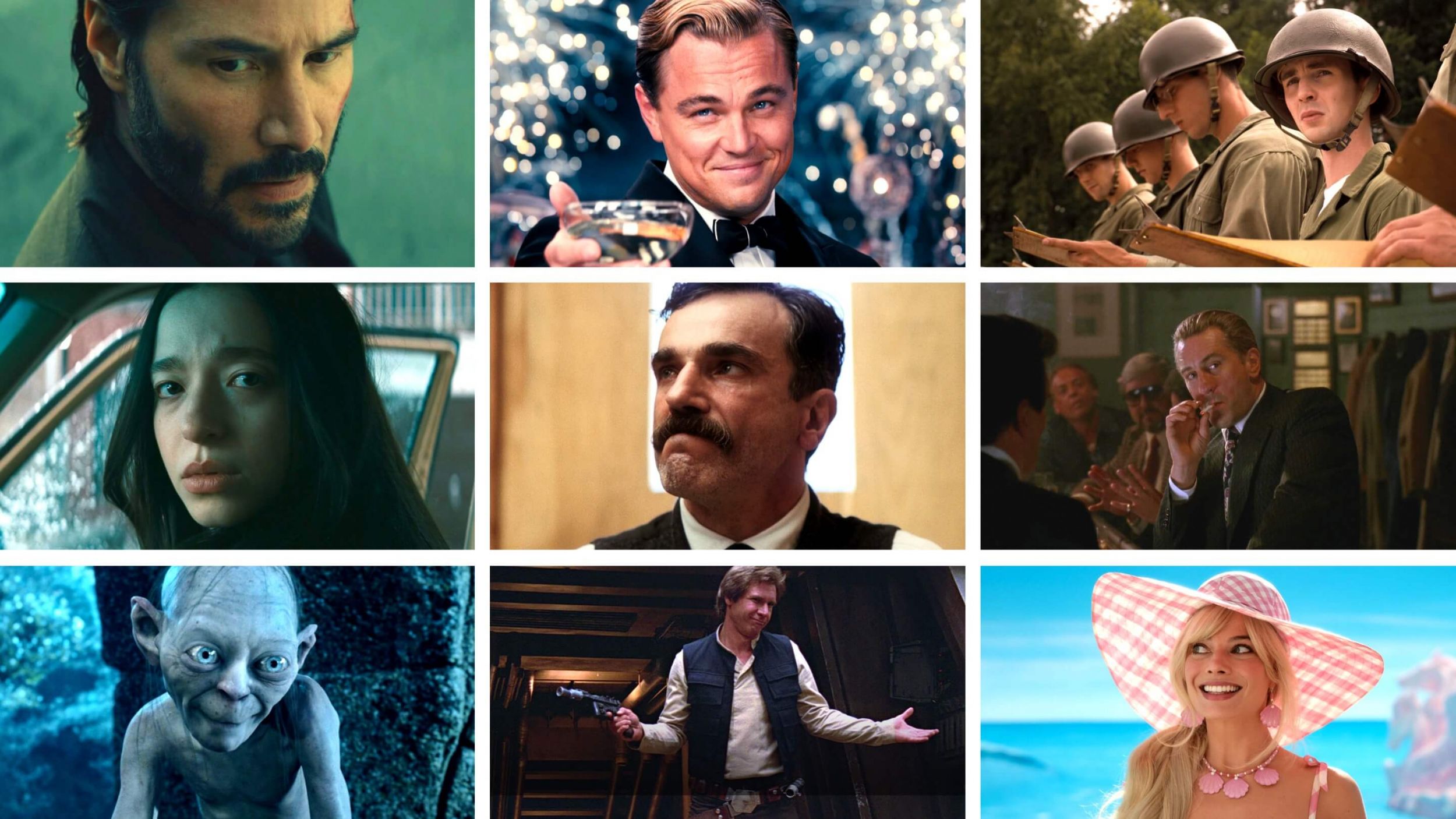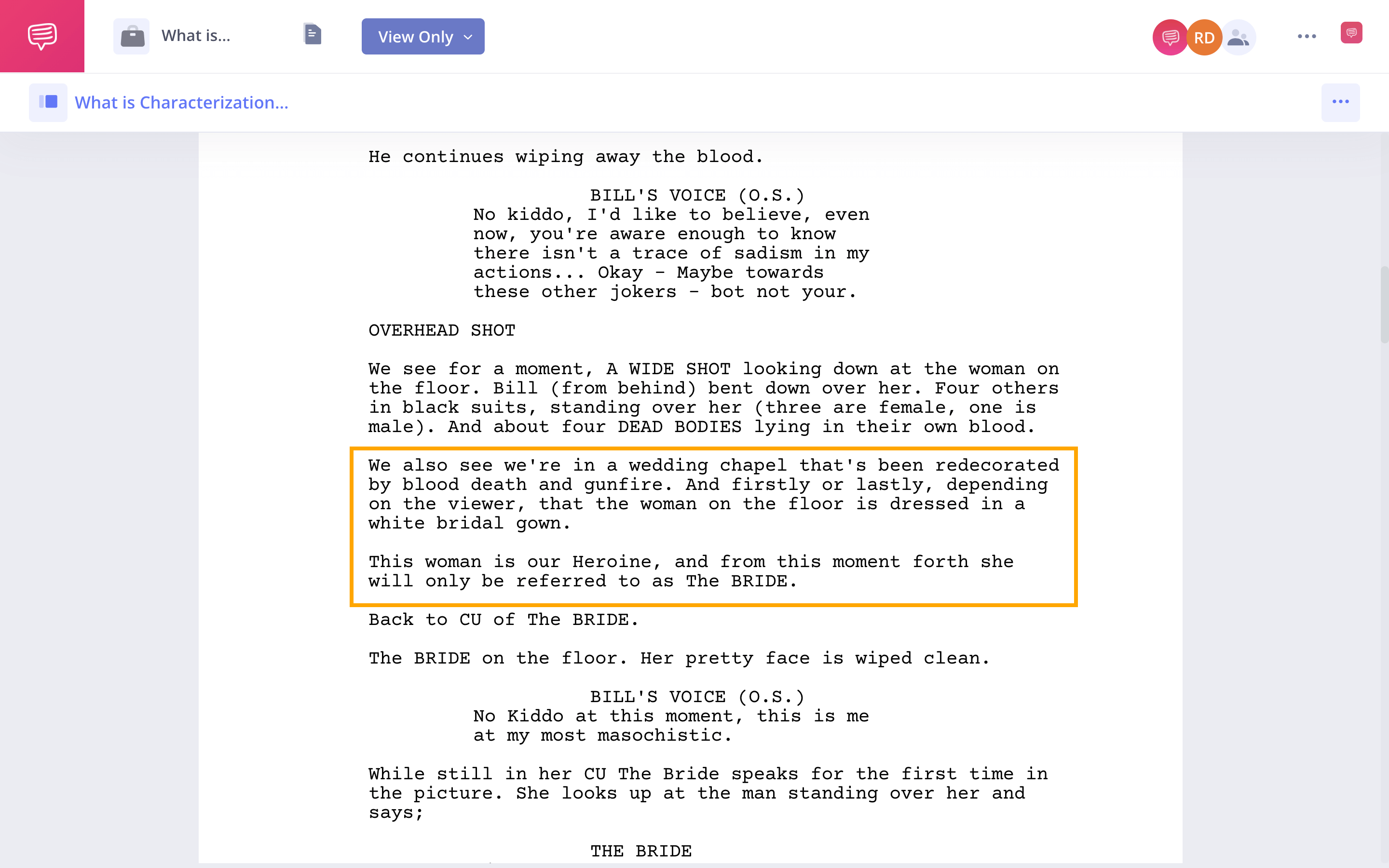How do writers make characters into people we can empathize with and understand? One way is through the use of characterization. But what is characterization? We’re going to answer that question by looking at an example from Kill Bill, and by listening to the perspective of some of the world’s foremost writers. But before we get into the examples, let’s review what makes direct characterization different from indirect characterization.
What Does Characterization Mean
Let's define characterization
What is characterization? Is characterization a literary device? The most simple explanation is the process of creating a character. In fiction, the writer's job is to build their characters from the ground up — who are they, where are they from, what's their defining qualities, etc.? But that doesn't mean that writers of non-fiction or biopics based on real people can ignore this process.
Before we jump into some examples and the different types, let's define characterization and why it's important.
CHARACTERIZATION DEFINITION
What is characterization?
Characterization is the process through which an artist communicates character to an audience. In writing, characterization is achieved through dialogue, actions, and descriptions. In visual mediums, characterization is still achieved through dialogue, actions, and descriptions, but it can also be achieved through costuming, hair and makeup, etc. The writer and/or director have made a series of decisions of how to present each character to the reader or audience. And so, everything they decide to include in this presentation is part of the characterization.
Types of Characterization:
- Direct characterization
- Indirect characterization
- Third Person Referential
Writers will often begin using character archetypes as a foundation but build on them with specific and individual layers of characterization. Let's look at the two main methods of how this is done.
Types of Characterization
Direct vs. indirect characterization
There are two types of characterization: direct and indirect. These types are almost always used in conjunction to support each other. At the same time, it's important to realize that these types of characterization have their unique values and should be given equal attention when writing.
Direct: How a character appears — their physical appearance and profession.
Here’s an example of direct characterization in Goodfellas.Characterization Examples • Direct Characterization in Goodfellas
We learn a lot about Jimmy’s (Robert De Niro) character just from his physical appearance — his slicked back hair, clean-shaven face, fine-tailored suit, etc. As a result, we’re able to tell that Jimmy is well-put together, or at the very least, he appears to be.
Indirect: How a character operates — their actions, thoughts, and opinions.
Here’s an example of indirect characterization also from Goodfellas.
Characterization Examples • Indirect Characterization in Goodfellas
In this scene, we learn about Jimmy’s character by what he says and what he does. That's why dialogue and actions are the two most important facets of indirect characterization.
Related Posts
What is Characterization Used For in Scripts?
Round vs. Flat Characters
Characterization requires knowledge about what type of character you’re writing. And so, characters can be divided into two camps: round and flat.
A round character is deeply realized, with complexities, contradictions, and wants that are evocative of a real person. These characters are usually protagonists or other prominent roles in a film.
A few examples: Clarice from Silence of the Lambs, Arthur in Joker, Gollum in Lord of the Rings, Michael in The Godfather. We could go on forever.
Gollum is a round character
A flat character, meanwhile, is a character who lacks these complexities. Instead, they’re two-dimensional, with just one or two character traits which define them. Usually, these characters aren't the lead, and if they are, that might be a problem.
A flat character doesn’t mean a bad character. For example, some great flat characters include Karen in Mean Girls, Cinderella, and C-3PO.
C-3PO: flat and loveable
A round character usually means much more characterization. Usually, this characterization continues throughout a film. There’s so much ground to cover.
A flat character, meanwhile, means quick characterization. Is your character a jock? Show them throwing a football and shoving a nerd into a locker and you’re done. Are they a bad guy’s henchman? Show them in a dark robe bowing to the antagonist with a line like, “Yes, master” and you’re done.Characterization examples
Characterization examples in literature and more
Most great stories use characterization. As such, the technique can be found in books, poems, music, and beyond. Let’s look at a few notable examples.
Characterization in The Catcher in the Rye
Holden Caulfield is one of the most famous characters in American literature, and this is due in large part to author J.D. Salinger’s razor-sharp characterization.
Just look at the opening sentence of the novel:
“If you really want to hear about it, the first thing you'll probably want to know is where I was born, an what my lousy childhood was like, and how my parents were occupied and all before they had me, and all that David Copperfield kind of crap, but I don't feel like going into it, if you want to know the truth.”
Immediately, we can tell that Caulfield is cynical and defensive, disinterested and perhaps unable to delve into anything too vulnerable.
Characterization in Anna Karenina
Tolstoy’s epics overflow with memorable and deeply realized characters. Perhaps his greatest protagonist, however, is Anna Karenina. She isn’t introduced until a few chapters into the novel, but when she is, it’s memorable. Here is one of the first descriptions of her:
“Madame Karenina, however, did not wait for her brother, but catching sight of him she stepped out with her light, resolute step. And as soon as her brother had reached her, with a gesture that struck Vronsky by its decision and its grace, she flung her left arm around his neck, drew him rapidly to her, and kissed him warmly. Vronsky gazed, never taking his eyes from her, and smiled, he could not have said why.”
Already, Tolstoy establishes that Anna has a mind of her own– a dangerous trait for a woman in 19th century Russia. He also makes clear the magnetic effect she has on people around her.
Characterization in Paradise Lost
With Paradise Lost, John Milton creates the ultimate anti-hero in Satan (yes, that Satan). In his epic poem, Milton molds the Devil into a complex and fascinating character. He uses characterization to get us inside Satan’s psyche:
“He of the first,
If not the first Arch-Angel, great in Power,
In favour and praeeminence, yet fraught
With envie against the Son of God”
Satan is consumed with jealousy, and that’s what leads him down the path of, well, pure evil.
Characterization in How Much a Dollar Cost
Yes, even songs can utilize characterization. In his song “How Much a Dollar Cost,” Kendrick Lamar details an interaction the narrator has with an unhoused person begging for money. Through his lyrics, Lamar characterizes the narrator as cold and hardened, while the beggar has more to him than meets the eye:
“He said, my son, temptation is one thing that I've defeated
Listen to me, I want a single bill from you
Nothin' less, nothin' more
I told him I ain't have it and closed my door”
This effective characterization plays a pivotal role as the song continues and delves into the nature of greed, class relationships, and faith.
What is Characterization in Screenwriting?
What's characterization in screenwriting
What are some considerations writers have with characterization in screenwriting? This process can be achieved through many different methods in screenwriting — but the first, and arguably most important aspect of building a character, is their first description.
In proper screenwriting format, whenever a new character is introduced in a screenplay, their name is written in all caps, along with a brief description of their physical appearance.
The first description is meant to give us an essential aspect of character. We imported the Kill Bill: Vol. 1 script into StudioBinder’s screenwriting software to take a closer look at how Quentin Tarantino introduces characters.
What’s Characterization to Tarantino? • Read the Kill Bill Screenplay
As you can see, The Bride’s introduction in the Kill Bill screenplay is clear. We’re shown who she is, what she’s doing, and where she might be going. But introductions are just one part of building a character — without development, characters will feel hollow.
UP NEXT
Write stronger characters
There’s a lot that goes into making a great character — much more than we touched on in this post about characterization. Up next, we analyze how plot and tone are used to develop characters and create situational conflict. We’ll also show you how to use a character development worksheet to organize your character’s actions and beliefs from beginning to end.

